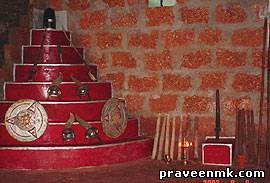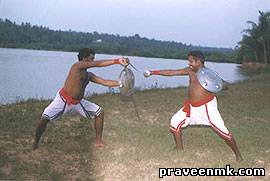Kalari Payat: Mother of All Martial Arts
Kalari Payat: One of the temple arts (kshethra kala) in South India, is a unique blend of physical, mental and spiritual practices to bring about an upheaval in man by using his basic instincts dormant deep in him to a higher level thereby realizing the Eternal through a scientific and systematic way.
 Kalari: Is a type of gymnasium
built according to the vaastushasthra giving each devathas
(subtle beings or higher beings) its particular place. In the
southwest corner of kalari there is a Poothara (an
altar) with seven steps representing seven female powers including
Bhadra Kali, and a Shiva linga on its top. Poojas are
performed to enhance the student's bhakthi (love). And action
performed with bhakthi will increase his concentration, which makes him
proficient rapidly.
Kalari: Is a type of gymnasium
built according to the vaastushasthra giving each devathas
(subtle beings or higher beings) its particular place. In the
southwest corner of kalari there is a Poothara (an
altar) with seven steps representing seven female powers including
Bhadra Kali, and a Shiva linga on its top. Poojas are
performed to enhance the student's bhakthi (love). And action
performed with bhakthi will increase his concentration, which makes him
proficient rapidly.
The inherent beauty of this art form lies in the harmonious combination of art, science and medicine. This art includes seven shasthras (sciences) like Vaastu, Jyothi, Marma, Ayurveda, Asana, Tantra and Mantra.
History: In 4th
century A.D Bodhi Dharma (Tat Moh) a Buddhist monk spread Kalari payatt to China which is called Shaolin Kung Fu..
This art reached its zenith in the 16 the century under different small
kingdoms.
Myths: It is believed that
sage Parasurama who built temples along south India introduced this art.
Causes of its degradation: Kalari payatt was banned by British in 1793. Secrecy is maintained in regard to many things, selfishness due to narrow view points (which involves inclination to own relatives, castes, politics, religion etc.). Other main reason contributed for the decline is that, it needs years of practice and dedication to master this art, a lack of competent people to learn and teach this great art to the coming generation.
 Culmination:
Psychic powers
invoked by using certain mantras was also used to fight against the enemy,
called choondu marma (Choondu means to index, they can even
transfer subtle powers through their index finger pointing it to the major
marmas, through which enemy can be made motionless) was mastered in
the past is now totally ignored because of its tough practices.
Culmination:
Psychic powers
invoked by using certain mantras was also used to fight against the enemy,
called choondu marma (Choondu means to index, they can even
transfer subtle powers through their index finger pointing it to the major
marmas, through which enemy can be made motionless) was mastered in
the past is now totally ignored because of its tough practices.
Gurukkal (Teacher): Gurukkal will be having thorough knowledge about marmas. Apart from physical training he also receives moral training from his teacher, includes how to guide students, and how to behave towards patients and peoples.
Presently Kalarippayatt is practised in many parts of Kerala. Different styles / methods of Payatts exists, among them Vadakkan style's 'Thulunadan' is considered as the highest.
Thulunadan Style: Vadivu (different body expressions, and movements that mimics different animals), Chuvadu (footworks or steps), Thayam (waiting for a chance to attack), Thancham (to make use of that chance) is highly stressed in thulunadan payatt, which makes it the highest among the other styles. Powerful and defined foot movements, the ability to execute the counter attack and the quality of the techniques is considered the best in Thulanadan style.
Watch Thulunadan Style of Kalari Training at MKG Kalari Sangham.